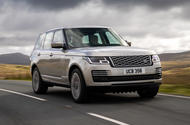Land Rover Range Rover D350 MHEV 2020 UK review

16-Oct-2020 00:01:24 | AutoCar
 Straight-six diesel engine gains 48V mild-hybrid tech for upmarket SUV’s final year
For a large chunk of the Range Rover’s past half century of life, fuel consumption and engine efficiency was something you were educated not to worry about.If you can afford that car, sages would say, you can surely afford the petrol. In the very earliest days, 12mpg was almost something to boast about, a measure of the owner’s ability to pay.It’s different nowadays. Creators of large luxury SUVs must deliver efficiency and comparatively low exhaust emissions – and then loudly publicise their achievement – simply to justify the products’ continued existence, and to meet rapidly tightening CO2 ‘fleet’ standards around the world. Which is why Jaguar Land Rover (JLR) is taking the trouble to launch mild-hybrid (MHEV in Land Rover language) diesel versions of its flagship SUV only about a year before the whole model gets replaced. On the fast-advancing global emissions timetable, there isn’t a week to lose.JLR has two mild-hybrid 3.0-litre straight-six diesel engine options for the Range Rover, the D300 and D350. They’re UK designed and built from the modular all-aluminium Ingenium architecture that’s used to create three-, four- and six-cylinder engines made at an ultra-modern factory near Wolverhampton for Jaguar and Land Rover models.They’re related to but different from the Range Rover plug-in hybrid, which has been on offer for well over a year. Instead, they replace the Ford-supplied V6 and V8 diesels in previous models and are thus far more economic for the company to make.The D350, tested here, officially delivers an impressive 30.8mpg on the WLTP cycle, with 241g/km of CO2. In a Range Rover Autobiography on 21in wheels, which is the form we tried, its 345bhp and 516lb ft of torque give the vehicle 0-62mph acceleration of 7.1sec (0.7sec better than the old V8’s time) and a top speed of around 140mph.More to the point, says JLR, the new straight-six diesel MHEV cuts CO2 output by around 13% and provides an (unspecified) reduction in NOx output while delivering that performance benefit. In a nutshell, it provides former V8 performance at around the same weight (about 80kg less) as the former V6. That weight saving, nearly all of it over the front wheels, improves the car’s weight distribution and driving dynamics. It is very apparent that this progress will be transferred pretty much ‘as is’ to the new Range Rover, just around the corner.
Straight-six diesel engine gains 48V mild-hybrid tech for upmarket SUV’s final year
For a large chunk of the Range Rover’s past half century of life, fuel consumption and engine efficiency was something you were educated not to worry about.If you can afford that car, sages would say, you can surely afford the petrol. In the very earliest days, 12mpg was almost something to boast about, a measure of the owner’s ability to pay.It’s different nowadays. Creators of large luxury SUVs must deliver efficiency and comparatively low exhaust emissions – and then loudly publicise their achievement – simply to justify the products’ continued existence, and to meet rapidly tightening CO2 ‘fleet’ standards around the world. Which is why Jaguar Land Rover (JLR) is taking the trouble to launch mild-hybrid (MHEV in Land Rover language) diesel versions of its flagship SUV only about a year before the whole model gets replaced. On the fast-advancing global emissions timetable, there isn’t a week to lose.JLR has two mild-hybrid 3.0-litre straight-six diesel engine options for the Range Rover, the D300 and D350. They’re UK designed and built from the modular all-aluminium Ingenium architecture that’s used to create three-, four- and six-cylinder engines made at an ultra-modern factory near Wolverhampton for Jaguar and Land Rover models.They’re related to but different from the Range Rover plug-in hybrid, which has been on offer for well over a year. Instead, they replace the Ford-supplied V6 and V8 diesels in previous models and are thus far more economic for the company to make.The D350, tested here, officially delivers an impressive 30.8mpg on the WLTP cycle, with 241g/km of CO2. In a Range Rover Autobiography on 21in wheels, which is the form we tried, its 345bhp and 516lb ft of torque give the vehicle 0-62mph acceleration of 7.1sec (0.7sec better than the old V8’s time) and a top speed of around 140mph.More to the point, says JLR, the new straight-six diesel MHEV cuts CO2 output by around 13% and provides an (unspecified) reduction in NOx output while delivering that performance benefit. In a nutshell, it provides former V8 performance at around the same weight (about 80kg less) as the former V6. That weight saving, nearly all of it over the front wheels, improves the car’s weight distribution and driving dynamics. It is very apparent that this progress will be transferred pretty much ‘as is’ to the new Range Rover, just around the corner.
Read More